Red clay courts hold a special place in the world of tennis. Unlike their hard and grass counterparts, clay surfaces significantly influence gameplay, demanding specific strategies, physical adaptations, and even customized equipment choices.
The most iconic tournament played on this surface is Roland Garros—the only Grand Slam held on clay. Known for producing long rallies, high-bouncing shots, and an emphasis on endurance and spin, red clay courts challenge players in unique ways.
But what exactly makes red clay so different? And why does it favor certain playing styles over others? Let’s explore the science behind this fascinating surface.
1. What Makes Red Clay Different?
Composition & Structure
Materials Used
Contrary to the name, red clay courts aren’t made from actual clay. Instead, they’re composed of finely crushed brick, shale, and other natural materials. The distinctive red color comes from the iron oxide in the bricks.
The top layer requires meticulous maintenance, as loose particles can affect both the bounce of the ball and the player's footing. A well-maintained clay court provides a consistent playing surface, while neglected courts may develop uneven patches that impact movement and shot accuracy.
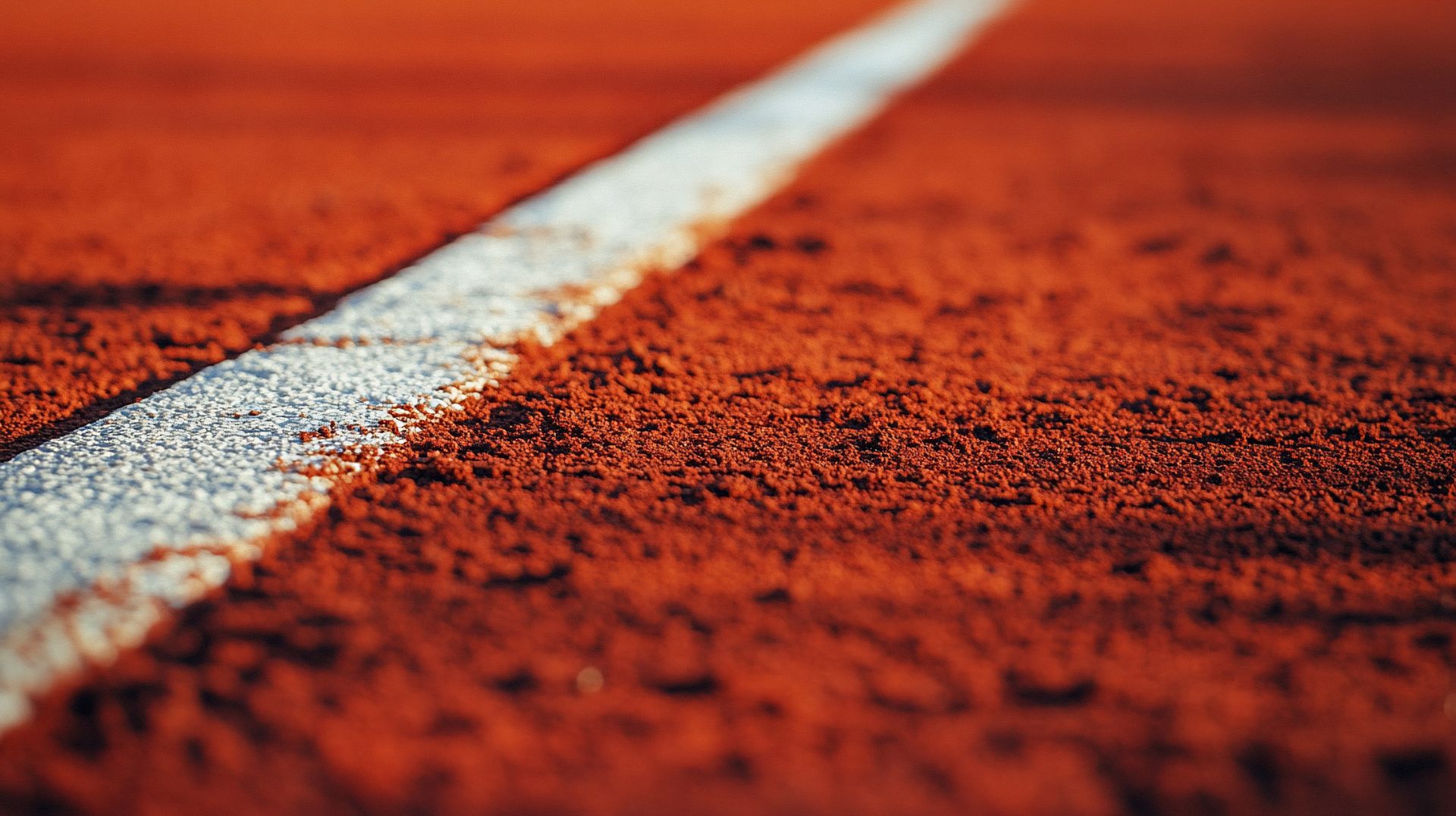
How It’s Built
A properly constructed red clay court consists of multiple layers:
- Base Layer: A thick gravel and stone foundation to ensure proper drainage.
- Intermediate Layer: A mix of limestone or other minerals to help with moisture retention.
- Top Layer: The finely crushed brick or shale that provides the surface texture.
The court requires continuous upkeep, as watering and rolling are essential to prevent excessive dust and ensure consistent playability.
During professional tournaments, groundskeepers often water the courts between sets to keep the clay in optimal condition.
How Red Clay Compares to Other Surfaces
So, how does red clay actually differ when it comes to match play?
- Hard Courts: Faster, with a more predictable bounce and less spin effect.
- Grass Courts: Very fast, with low bounces and a surface prone to unpredictable variations.
- Clay Courts: The slowest, with a higher bounce, longer rallies and more opportunities for spin-based play.
Curious about what really sets court surfaces apart? Dive into our article on the role of friction in tennis!
Curiosity: Clay Was Born to Protect Grass
Clay courts were originally invented in the late 19th century by English lawn tennis players in the south of France.
Due to the intense Mediterranean heat, the grass courts dried out and died quickly. To preserve them, players began spreading crushed terracotta pots over the grass, which eventually led to the development of red clay as a standalone surface.
What started as a protective layer became one of the sport’s most iconic surfaces.
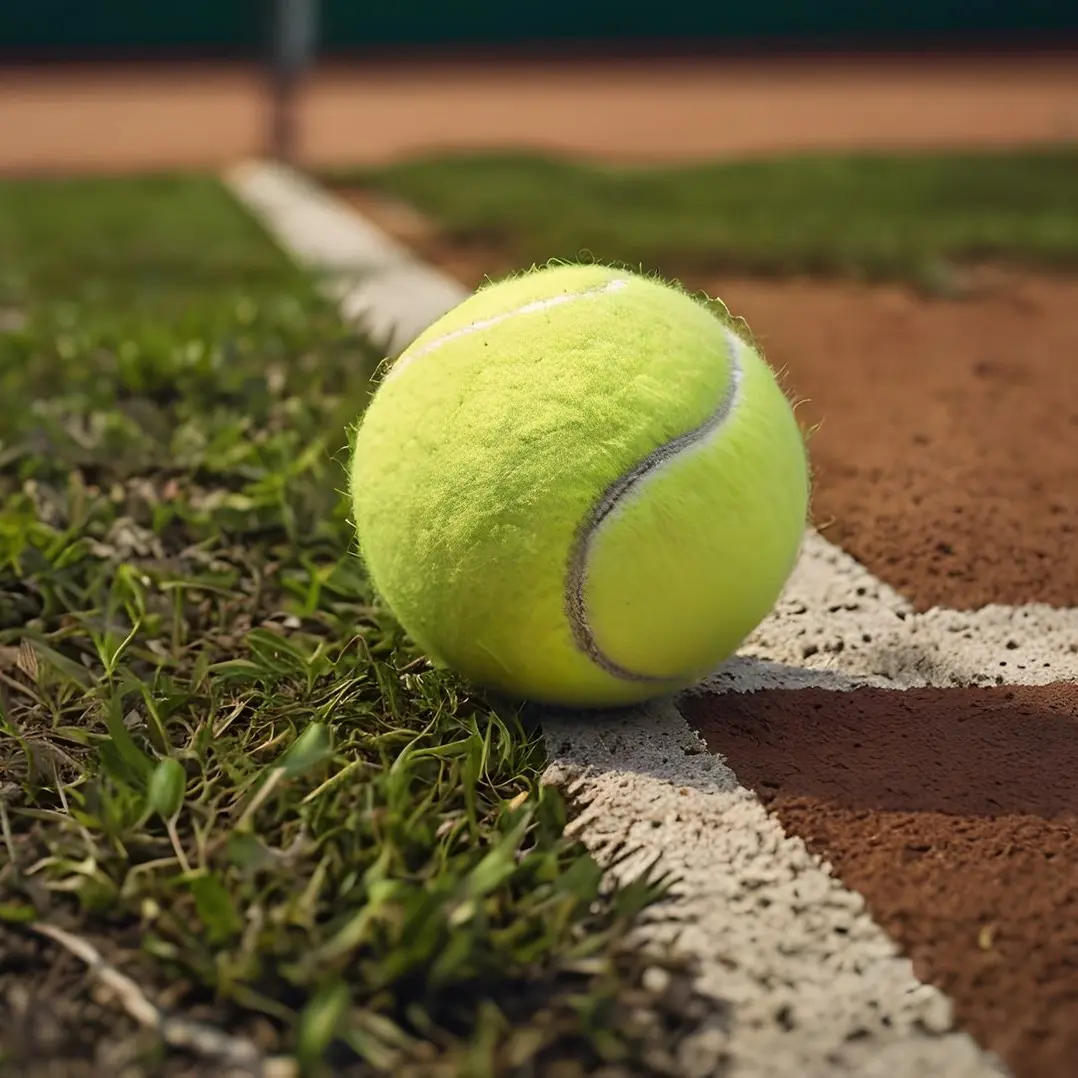
2. The Physics of Clay: How the Surface Affects the Ball and Players
Ball Behavior
One of the defining characteristics of red clay is its impact on the ball’s movement:
- Higher Bounce: Due to the softer surface, balls dig into the court, increasing the height of the bounce.
- Slower Speed: The increased friction slows the ball down after it lands.
- Spin Effectiveness: Clay amplifies topspin, making it a deadly weapon.
Topspin-heavy strokes gain an extra advantage on clay because the higher bounce pushes opponents farther behind the baseline, making it harder for them to attack the ball aggressively. This is why players like Rafael Nadal and Carlos Alcaraz, known for their topspin, thrive on this surface.
Sliding Mechanics
Movement on clay differs from other surfaces because players slide into their shots rather than stopping abruptly.
This sliding reduces stress on the joints but requires an entirely different footwork technique. Players must master controlled slides to recover quickly after striking the ball.
Footwear also plays a role: specialized clay-court shoes have a unique herringbone tread pattern that provides better grip while allowing controlled sliding.
Without the right shoes, players may struggle with balance and stability.
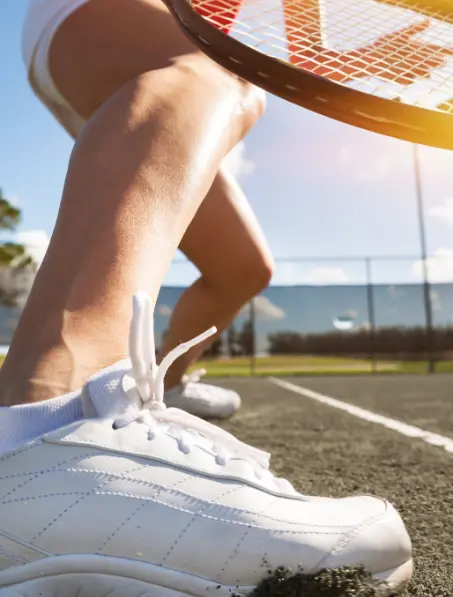
Energy Absorption
Since clay absorbs more energy than hard courts, it’s easier on the body in terms of impact. However, rallies last longer, making it more physically demanding from a stamina perspective. Players need strong leg endurance and a high fitness level to compete at the highest level on clay.
🔬 Technical Insight: Moisture plays a critical role in clay court density.
A properly watered clay court ensures optimal sliding conditions and maintains consistent bounce characteristics. Too dry, and it becomes dusty; too wet, and the ball skids unpredictably. The ideal balance is maintained by carefully monitoring humidity levels and applying just the right amount of water before and during matches.
3. Tactical Adjustments: How Clay Changes the Game
Baseline Domination
Unlike faster surfaces, where aggressive net play is more common, clay rewards baseline consistency. Players who thrive on long rallies and strategic point construction tend to excel. Successful clay-court players develop a patient style, building points carefully to force errors rather than relying on outright winners.
Many clay-court specialists, such as Gustavo Kuerten and Diego Schwartzman, rely on their ability to grind out long points rather than overpower opponents with sheer pace.
Shot Selection
We’ve already seen how topspin thrives on clay; here, we take a tactical lens to examine which shots work best in a match setting:
- Topspin-heavy strokes create higher bounces, pushing opponents farther back.
- Drop shots are highly effective due to the slower surface.
- Angles and width become essential for moving opponents out of position.
Because of the higher bounce, traditional flat shots lose some of their effectiveness. Players who can generate extreme spin and disguise their drop shots gain a clear advantage. Additionally, two-handed backhands often struggle on this surface compared to single-handed backhands, which naturally produce more topspin.
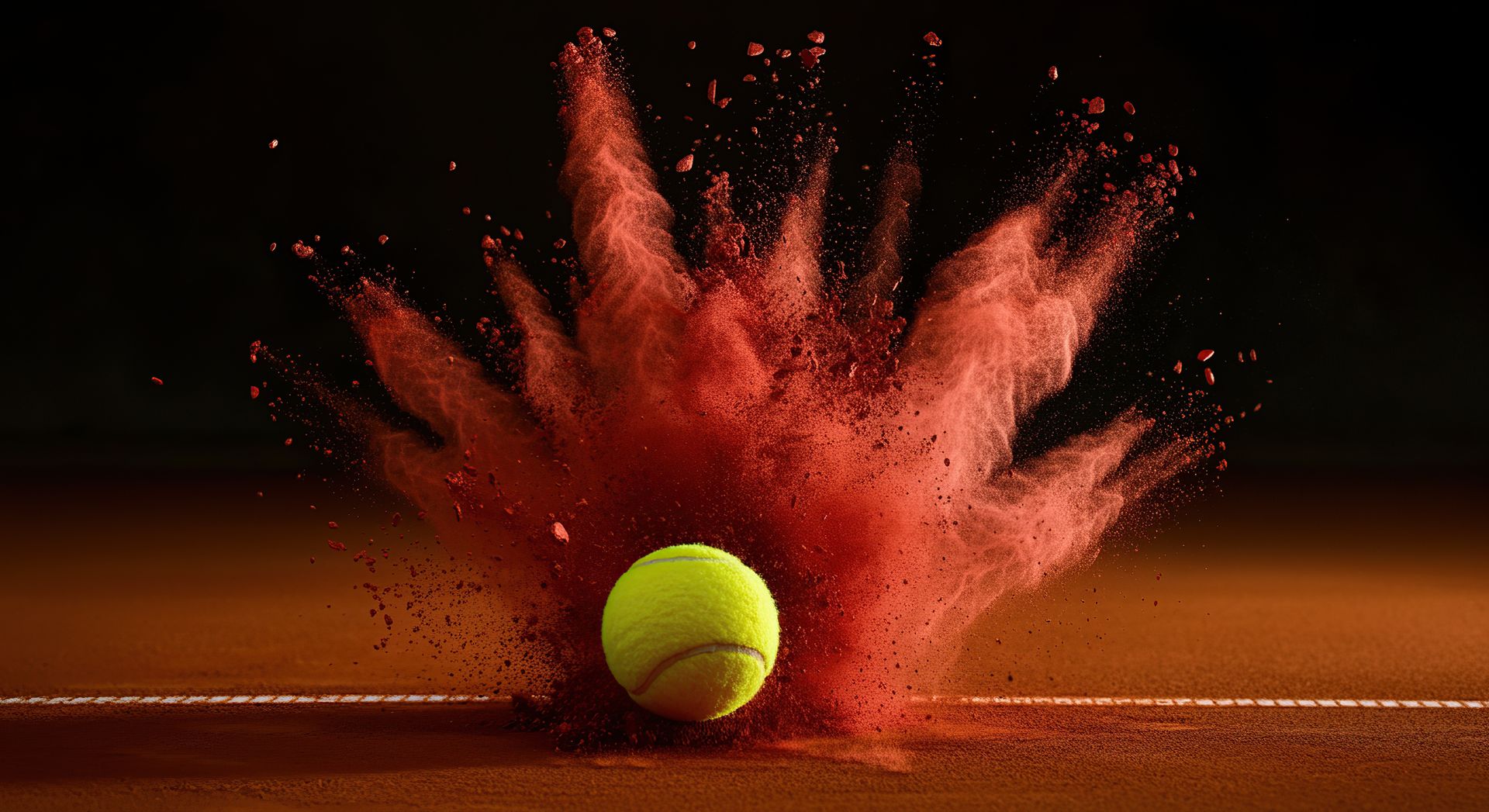
Endurance & Patience
Clay matches are often grueling, testing both physical endurance and mental resilience. Players must be prepared for extended rallies and multiple shot exchanges before earning a point. The ability to reset and maintain focus after long points is crucial.
One of the most famous matches showcasing clay-court endurance was the 1984 French Open final between John McEnroe and Ivan Lendl. McEnroe, a serve-and-volley specialist, dominated early but was eventually worn down by Lendl’s relentless baseline play and superior fitness—proving just how physically demanding clay-court tennis can be.
🎾Pro Example: Björn Borg’s Clay-Court Streak Set the Standard, Rafael Nadal redefined it
Swedish legend Björn Borg holds one of the most impressive clay-court records in tennis history: 46 consecutive match wins on clay between 1977 and 1979. His dominance helped elevate the prestige of Roland Garros and ushered in a new era of baseline endurance and topspin mastery.
While Borg set the standard, Rafael Nadal redefined it: with 14 Roland Garros titles to his name, he remains the only player awarded a full-size Coupe des Mousquetaires, a testament to his unmatched legacy on clay.
Beyond Nadal, other players have developed specialized strategies to succeed on the surface. Novak Djokovic has refined his movement and shot variation to rival Nadal’s clay-court prowess, while rising stars like Casper Ruud and Stefanos Tsitsipas continue to sharpen their games in pursuit of Grand Slam glory.
4. The Role of Spin: Why Topspin Is King on Clay
We’ve already broken down the physics behind tennis shots — now it’s time to uncover why topspin absolutely dominates on clay!
Physics of Topspin & Clay
Clay courts fundamentally alter the way a tennis ball interacts with the surface. Unlike hard courts, which produce a predictable and relatively low bounce, clay courts grip the ball, accentuating the effects of topspin. When a player applies heavy topspin, the ball rotates forward at high speed, increasing its interaction with the clay. As a result, the ball kicks higher and slows slightly upon bouncing, making it more difficult for opponents to strike an aggressive reply.
This high bounce forces opponents to adjust their strike zone, often compelling them to hit balls above shoulder height—an uncomfortable and less effective position for most players.
Why Slices & Flat Shots Struggle
Slice and flat shots, which are effective on faster surfaces like grass and hard courts, lose much of their potency on clay. A slice, which relies on underspin to keep the ball low and skidding, instead sits up on clay, giving opponents extra time to prepare their response.
Additionally, since clay is slower, flat shots—which travel with less spin and a lower trajectory—become riskier. The higher bounce means flat shots must be hit with even greater precision to avoid unforced errors.
Players who rely on these styles often find themselves at a disadvantage against heavy topspin hitters.
The Kick Serve Advantage
The kick serve—a topspin-heavy serve that jumps up off the court—is an incredibly effective weapon on clay.
The surface’s natural properties amplify the ball’s upward trajectory, making it more challenging to attack.
Opponents are forced to return serves from an awkward position, often well above their shoulders, reducing their ability to be aggressive on return games.
This makes holding serve easier for players who can consistently generate high-RPM kick serves.
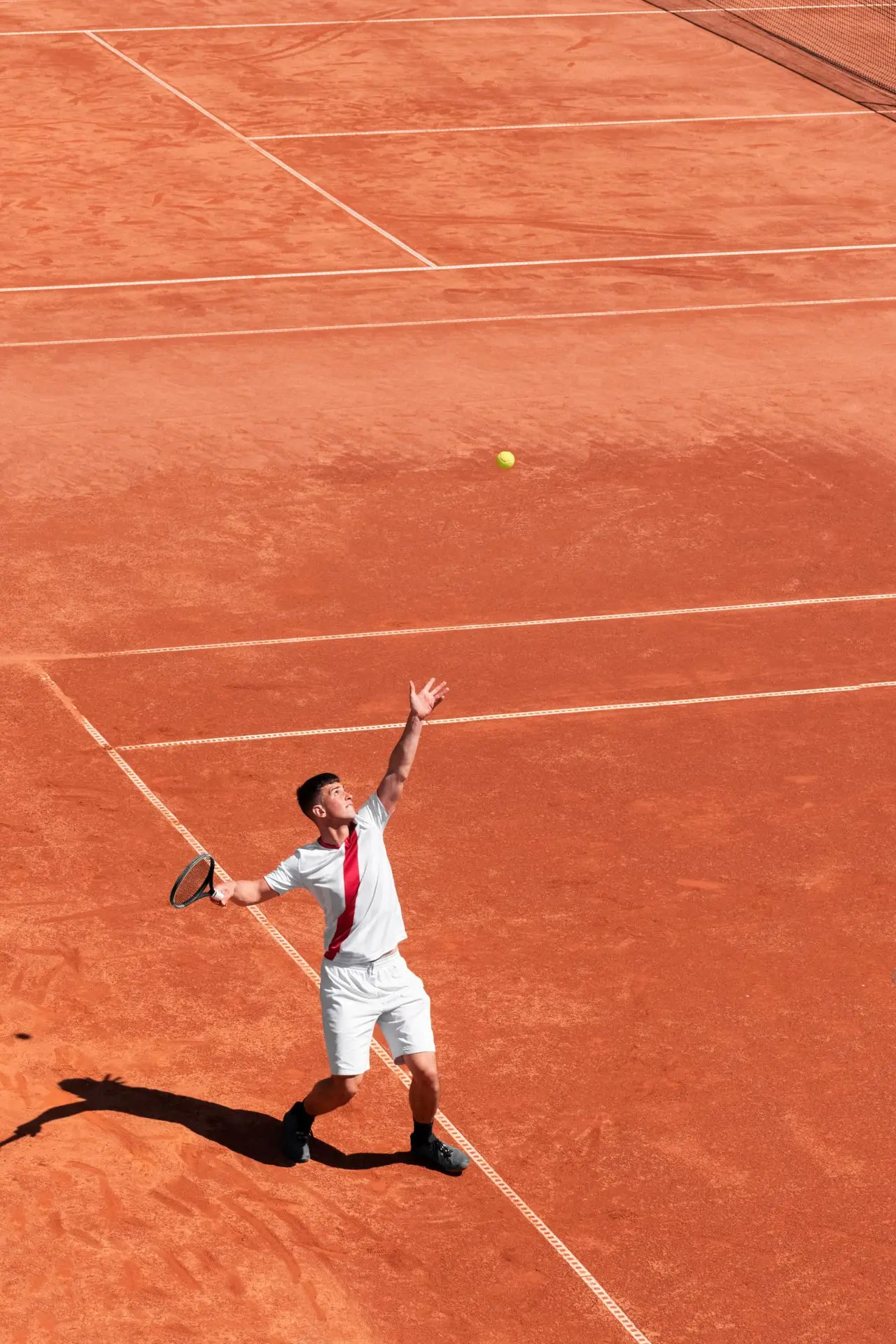
📊 Technical Insight: Studies using Hawk-Eye data from ATP clay-court tournaments have shown that topspin forehands on clay average around 20–25% more revolutions per minute (RPM) compared to the same shots on hard courts.
Rafael Nadal, for example, generates around 3,200 RPM on his forehand, with peaks reaching 5,000 RPM—a crucial factor in his clay-court dominance. The added topspin makes the ball kick up aggressively, pushing opponents into defensive positions.
5. Court Maintenance: Why Clay Is a Living Surface
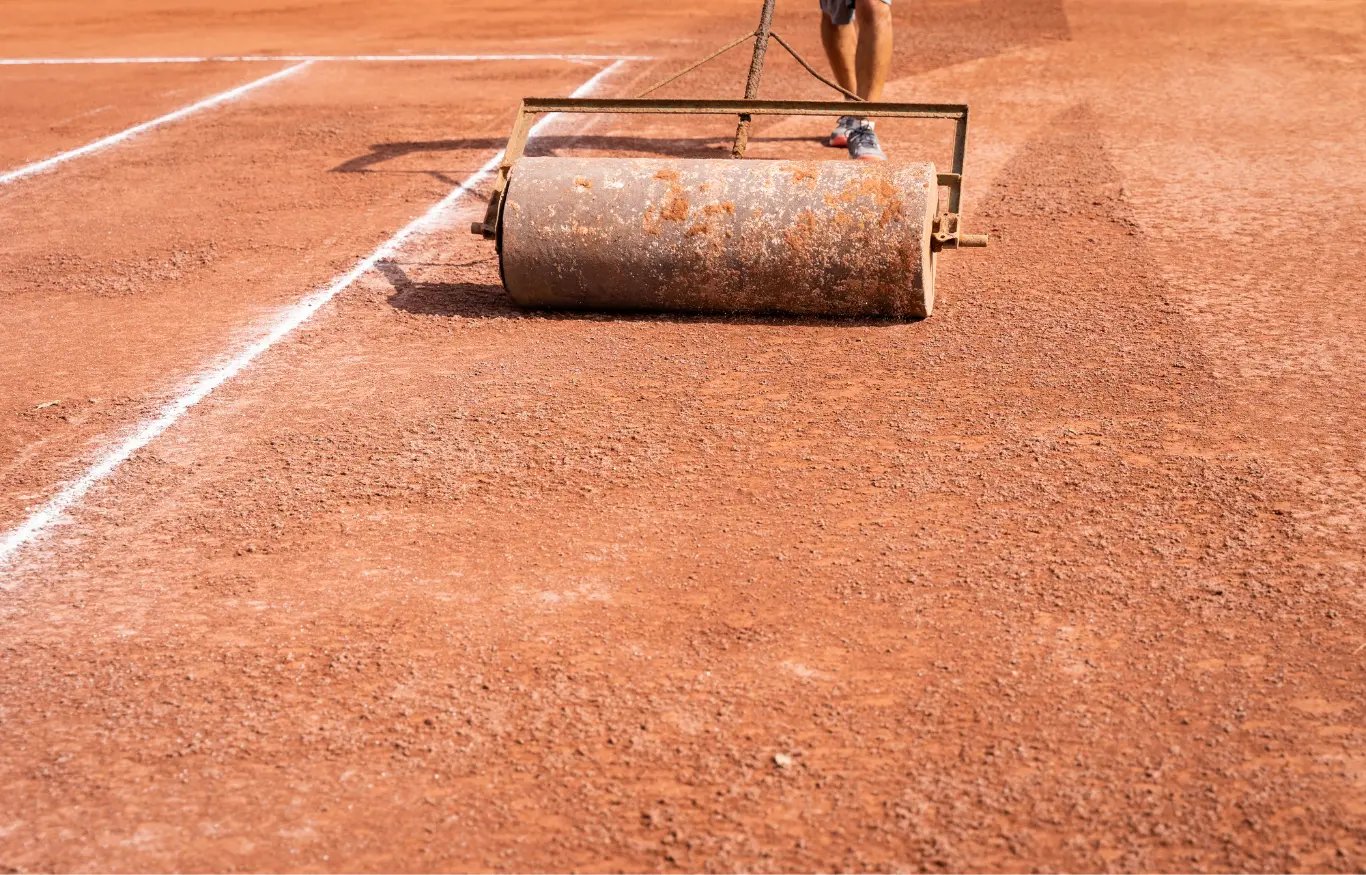
Daily Maintenance: Watering & Rolling
Unlike hard or grass courts, clay requires meticulous daily care to ensure consistent play. Courts must be watered regularly to maintain optimal moisture levels, which helps prevent excessive dust and keeps the surface compact.
Rolling is equally important—it preserves a uniform texture, reduces irregular bounces, and ensures ideal sliding conditions.
How Clay Courts Evolve During a Match
Clay courts transform significantly over the course of a match:
- Early Matches: Freshly watered and rolled courts play slower and feel heavier. The added moisture keeps the surface dense, absorbing more of the ball’s energy and lowering the bounce.
- Late Matches: As the court dries out, it becomes looser and faster. The ball bounces higher, and the surface may grow more slippery, requiring players to adjust both movement and shot selection.
Weather & Climate Impact
Environmental conditions also shape how clay behaves:
- Humid Conditions: Moisture in the air keeps the surface heavy, producing slower rallies and reducing the ball’s penetration through the court.
- Hot, Dry Conditions: Dry heat accelerates evaporation, increasing bounce height and decreasing traction. This often favors aggressive players who take the ball early and strike decisively.
🎾 Curiosity: Did You Know?
At Roland Garros, the red clay layer is just 2mm thick. Below it lies a foundation of crushed limestone, providing both stability and the signature bounce and sliding properties of the court.
6. Clay Court Championships: Where & When the Biggest Battles Happen
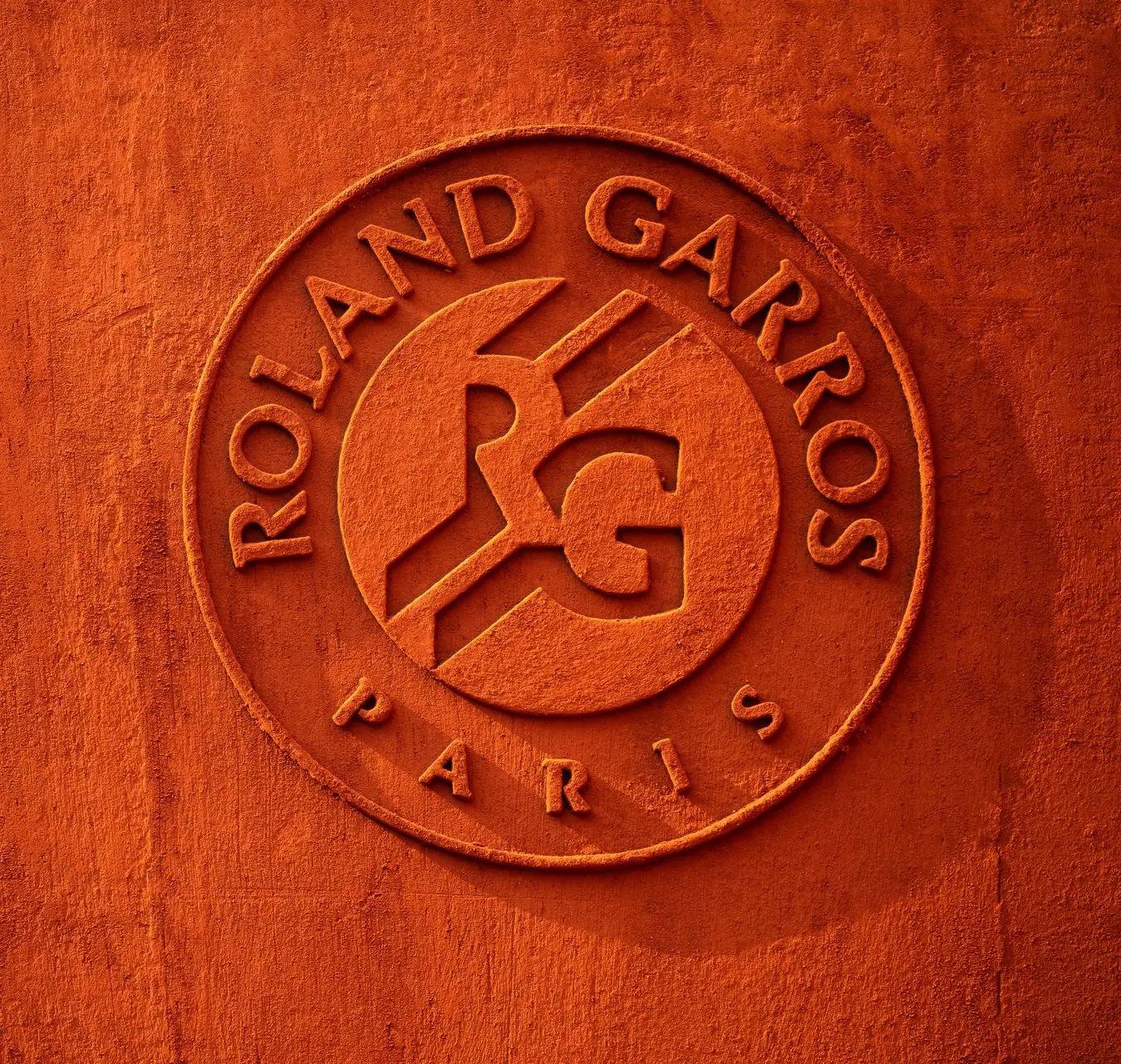
Key Clay Tournaments
The professional clay season is a defining stretch of the tennis calendar, featuring several iconic events:
- April → Monte Carlo Masters: The traditional clay-court opener, known for its slow pace and stunning seaside views.
- May → Madrid Open & Rome Masters: Madrid’s altitude creates a faster-playing clay, while Rome offers a purer clay experience, rewarding patience and precise baseline play.
- June → Roland Garros (French Open): The pinnacle of clay-court tennis. Winning here demands endurance, tactical intelligence, and unwavering focus.
Why the Clay Season Matters
Success during this stretch often signals strong performances for the rest of the year. Clay hones essential skills—like patience, footwork, and point construction—that transfer well to all other surfaces. Many legends, including Nadal, Djokovic, and Federer, credit their clay-court development as crucial to their overall mastery.
📈 Example: Monte Carlo & Rome as Roland Garros Indicators
Historically, players who shine in early season clay court championships like Monte Carlo and Rome often carry that momentum into Roland Garros. These tournaments are essential proving grounds for testing endurance, adapting tactics, and fine-tuning movement before the ultimate clay challenge in Paris.
7. Best Strategies & AMbelievable Gear for Clay Court Players
Footwear Matters!
Clay court shoes are designed to enhance sliding control and overall stability. They feature a herringbone (zig-zag) tread pattern, specifically engineered to grip the loose surface particles of red clay while still allowing controlled sliding. This pattern helps prevent clay buildup on the sole and maintains traction during lateral movements.
Additionally, these shoes often include:
- Tighter-knit mesh uppers, to keep fine clay dust out,
- Reinforced toe guards, to handle the wear and tear from frequent sliding,
- And a lower-to-the-ground profile, for improved stability.
This unique combination supports the stop-start nature of clay-court movement, enabling players to slide into shots without sacrificing balance or control.
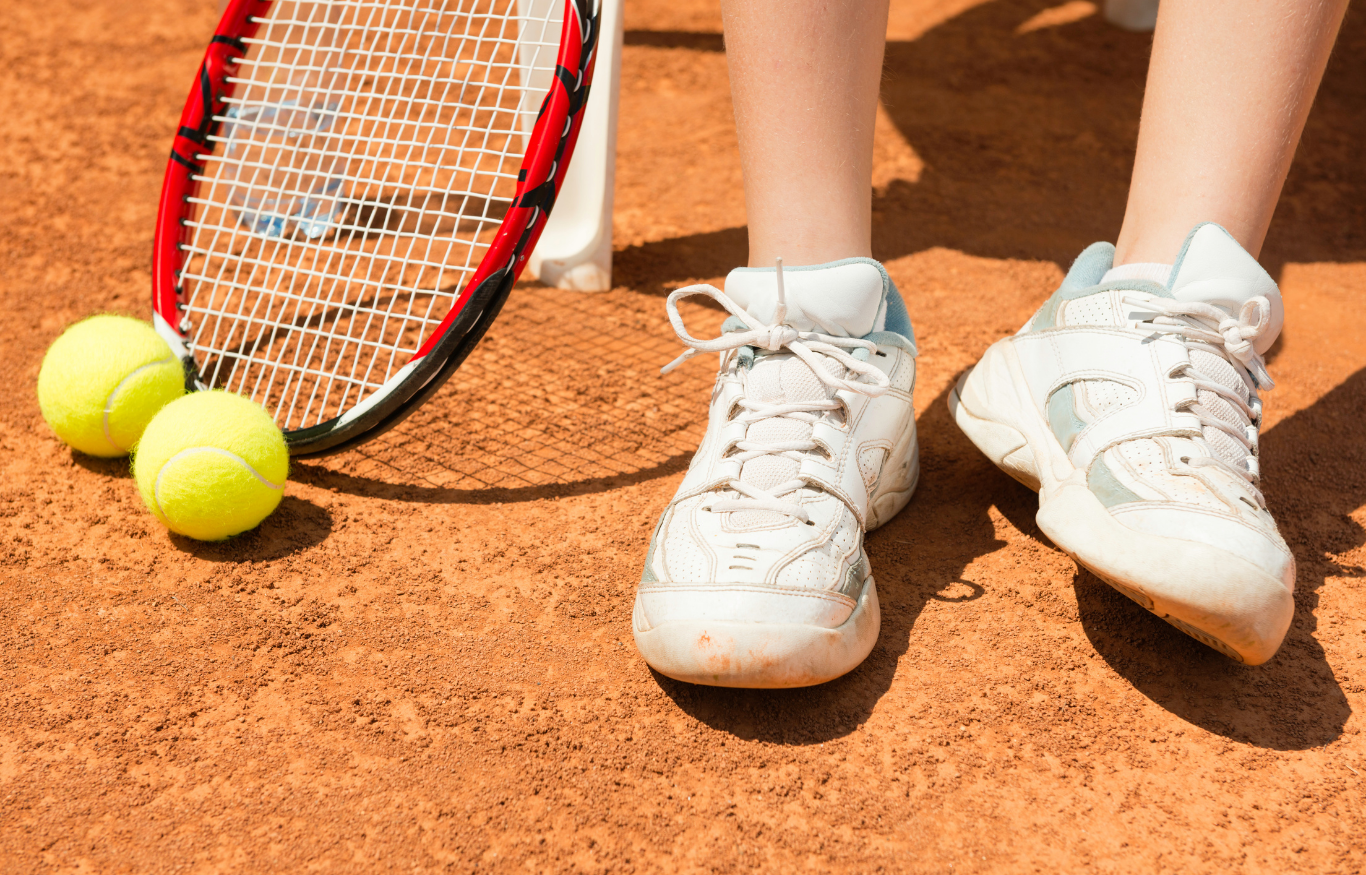
Racket & String Choices: Spin & Control Optimization
- Rackets: Players often use frames with larger head sizes and open string patterns to generate maximum topspin.
- Strings: Softer polyester strings grip the ball more effectively, boosting spin potential.
Due to the slower pace and increased friction, balls used on clay tend to accumulate more dust and absorb moisture, which makes them slightly heavier as matches progress. This can reduce speed and flatten bounce over time. As a result, players often string their rackets with lower tension on clay to increase power and maintain depth, compensating for the court’s energy-absorbing properties
Gear Spotlight: Tennis Vibration Dampeners can further fine-tune racket feel
The AMbelievable Tuned Control, for example, is designed to pair especially well with flexible frames and mid-range tensions (22–27 kg), a common setups for clay.
Its ability to reduce vibration without muting feedback makes it ideal for the extended rallies and spin-heavy exchanges that define red clay tennis.
Give it a try during your next clay session and, if you do, let us know how it feels! We’d love to hear your feedback.
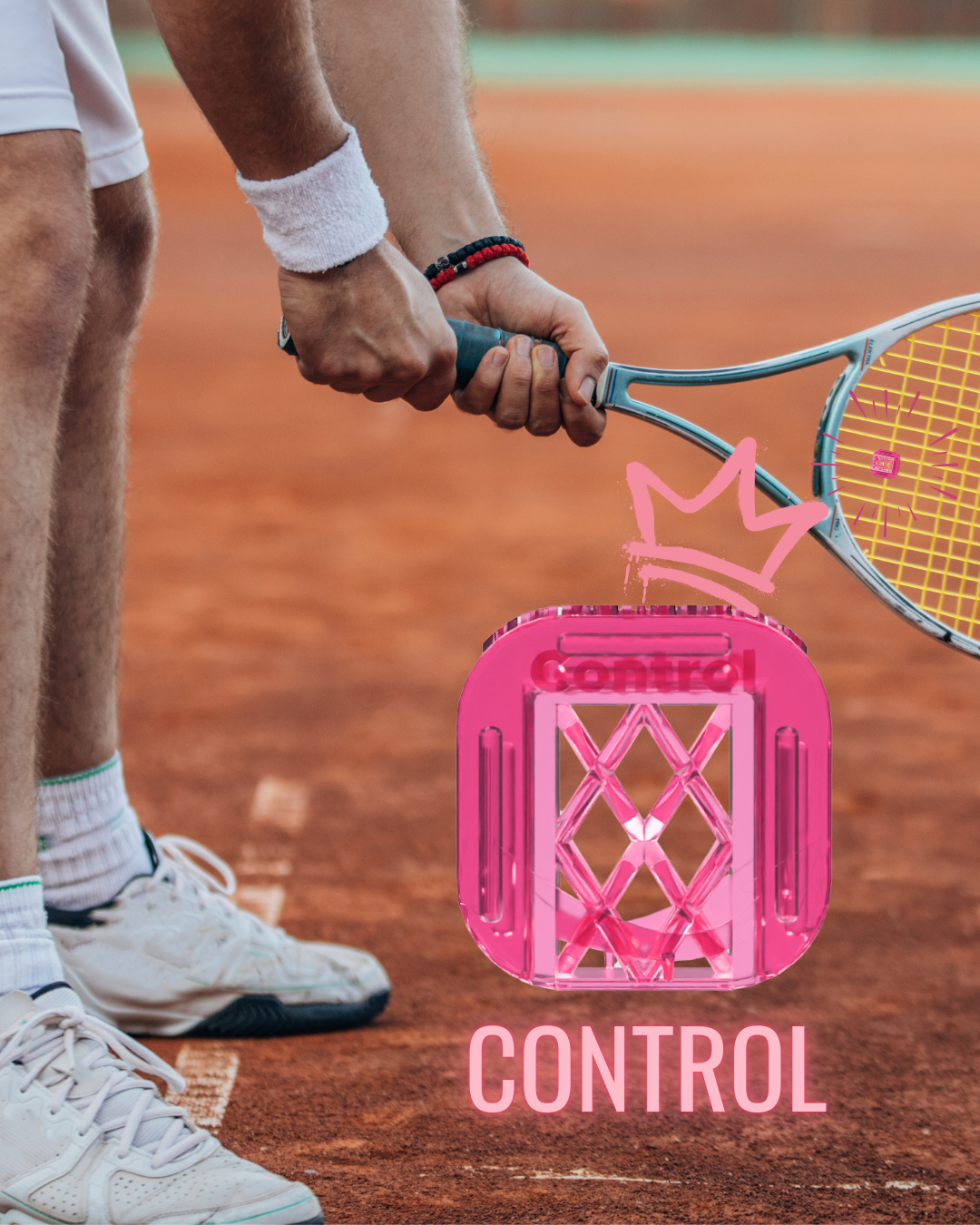
Tactical Play by Style
Different player profiles adapt to clay in unique ways:
- Aggressive Baseliners (e.g., Carlos Alcaraz): Rely on heavy topspin, sharp angles, and deep positioning to dictate points.
- Defensive Players (e.g., Rafael Nadal, Daniil Medvedev): Use superb court coverage and consistency to grind down opponents over long rallies.
- All-Court Players (e.g., Novak Djokovic): Blend variety—drop shots, net approaches, spin shifts—to keep opponents off balance.
Conclusion: The Legacy & Future of Red Clay
Clay courts have long been revered as the most strategic and physically demanding surface in tennis. The legacies of champions like Björn Borg, Gustavo Kuerten, and Rafael Nadal highlight the unique skill set and mental toughness required to succeed on clay.
As the sport evolves, so too does clay-court tennis. Enhanced fitness, smarter equipment choices, and tactical adaptations are ensuring that this historic surface continues to be a vital and dynamic part of the modern game.
For aspiring players, training on clay builds a foundation in movement, patience, and resilience—qualities that elevate performance across all surface.